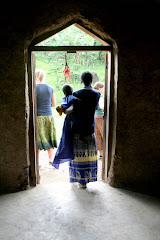 The heavily cultivated hills of Southwest Uganda with the Albertine Rift Valley seen in the background.
The heavily cultivated hills of Southwest Uganda with the Albertine Rift Valley seen in the background.
I literally live tucked into a corner of the world. One of the few places I have ever been that you can drive into but no through roads lead out except the gnarled dirt track that brought you there. To get to this place you must first travel 10 hours from the capital,
Sitting high above this valley atop one of the ridge crests stands two brand new sentinels with flashing red lights. The recently built MTN and
For the last year I have struggled on a daily basis to pass a basic text or communication that would save me two hours of travel. The only place where network could be found was at a tea field that sits across from a notch in hills of the valley where a weak signal could seep through and provide a broken conversation. Many of these conversation necessitated that I drag a translator with me making the communications that much more difficult to coordinate.
Now…I can make texts to my best friends in the states from the comforts of the porch of my house as I look into the depths of the primeval
Too often the target of humanitarian work is on the poorest communities (ie the Batwa) who do not have access to cell phones and even if they did, do not speak Rzungu.
(Rzungu is the language spoken by the Mzungu aka English!) In most situations the Batwa must resign to speaking through middle men who often have their own agendas and/or opinions that can hurt the quality of the information being passed on, and in some cases completely change the meaning.


A meeting session that has moved into the cramped indoors to escape the rain.
In addition to improved phone communication we have focused on dialogue through meetings that engage and involve community members NOW. If you have been reading this blog it may come as a surprise to you that this 3H grant includes provision for community nutrition in the form of goat projects. Three Batwa communities have been provided one herd of goats each to care for communally and to share after the goats have multiplied. We felt like meetings in these communities were a great place to start to provide the necessary support for the ongoing projects but also to better understand unseen challenges and benefits to inform future projects.
Follow up for the goat projects has come in the form of a number of formal and informal meetings looking to bring out the issues communities are facing with the goats and what their potential resources are to find solutions.
 Goats with their salt lick. These store bought bars of salt will most likely be replaced by local salt mined from the salt flats of Lake Edward.
Goats with their salt lick. These store bought bars of salt will most likely be replaced by local salt mined from the salt flats of Lake Edward.

Boys having a blast climbing around the goat shed. An unintended benefit of goats!
Raising goats as a community is a complicated undertaking that includes a large amount of coordination and cooperation and necessitates strong financial decision-making on how to benefit from the goats in the end. Holding these meetings has played a central role in our understanding of the direction the community wants to take the projects. Having this direction allows us to provide trainings and to encourage meetings relevant to community goals and concerns.

Innocent, a Batwa member preparing a syringe for an injection of Malaria medication.

Spraying goats to combat ticks and mange.
At times we are showered with questions about if we can provide work gloves, jerry cans, flashlights and other items that we see as provisions that the community must provide for themselves. Despite these superficial questions we came upon some major issues that the communities raised. These included needing more training on providing injections, better cooperation for feeding and cleaning, and wanting further trainings on using manure.
Following the thread of issues among the three communities we found that land ranked top among all concerns. Further probing into the issue we realized that crop raiding of the Batwa goats onto Bakiga land was a major issue that was exacerbated by resentment by the Bakiga neighbors of the goat project going to the Batwa. If you will remember from previous posts the Bakiga are the dominant tribe in
Compounding the land issue is the small plots of land that the Batwa live on and the fragmented nature of the land. Keberimo and Bikuto Batwa communities live on two plots of land separated by Bakiga land and the community of Kitariro lives on three disconnected plots of land. This situation requires the Batwa to cross Bakiga property to graze their goats on other plots of land. I never thought this would be a big issue to just move goats from one plot of land to the next until I watched a group of hungry goats charge out from their shed in Keberimo. Surrounded by Bakiga crop land the goats turned into giant black and white locusts devouring cassava leaves and corn stalks. At that point I truly understood how fostering relations with neighbors is central to the success of raising goats and how necessary opening lines of dialogue was needed to be a top priority.
 Community worker Beth Kyamazima working with the Batwa settlement of Keberimo writing down the ideas of the community members.
Community worker Beth Kyamazima working with the Batwa settlement of Keberimo writing down the ideas of the community members.
More to come folks. Let me know what your thinking as you read these posts!






